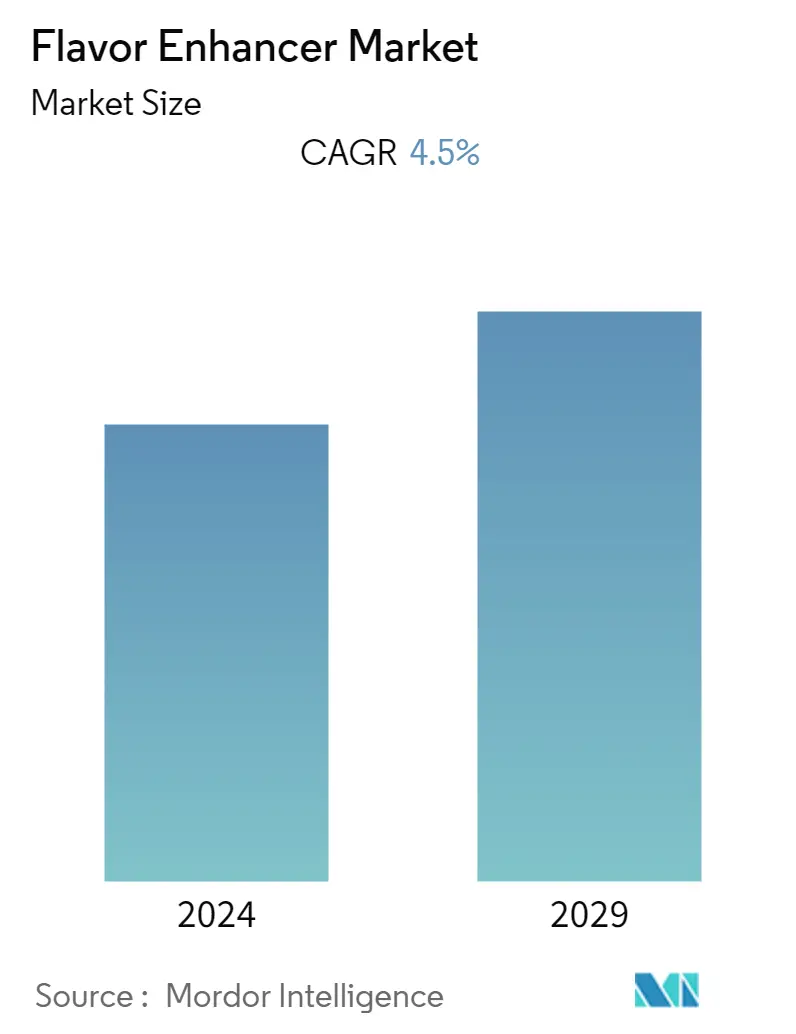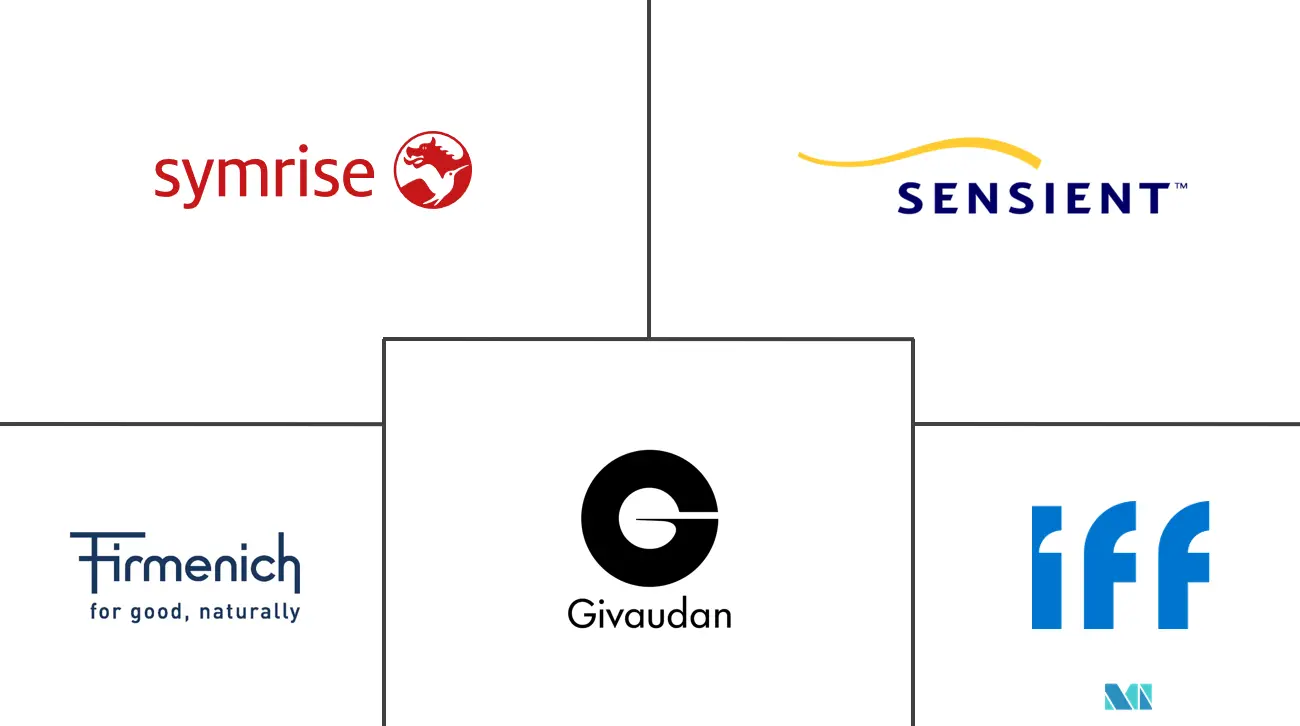Market Size of Flavor Enhancer Industry

| Study Period | 2019 - 2029 |
| Base Year For Estimation | 2023 |
| CAGR | 4.50 % |
| Fastest Growing Market | Asia Pacific |
| Largest Market | Asia Pacific |
| Market Concentration | Low |
Major Players
*Disclaimer: Major Players sorted in no particular order |
Flavor Enhancer Market Analysis
The Flavor Enhancer Market is projected to register a CAGR of 4.5% over the forecast period.
The increase of flavor enhancers made from citrus fruits including tamarind, yuzu, orange blossom, lime, and others is promoting the "exotic effect," which is being sustained by consumers' increasing acceptance of strange and exotic food and beverages from around the world. Fusion-based flavor combinations are also growing in popularity for the development of cutting-edge food items. Ingredient producers are helping food companies in delivering novel flavor profiles to meet the demands of changing consumer needs, particularly in the United States. For instance, in March 2022, Flavorchem introduced a range of citrus flavors for use in immune health products. Since citrus flavors are becoming increasingly popular as consumers associate them with immune support.
The increasing popularity of Asian cuisines across the world is another primary reason for driving the market. Recently, many companies have launched natural flavor enhancers to meet the rising demand for clean labels.
Aside from the emphasis on introducing novel flavor profiles, the food flavors enhancers sector is also benefiting significantly from the increased emphasis on the development of innovative flavor manufacturing processes. For instance, in February 2021, Givaudan launched its unique Advanced Tools for Modelling (ATOM), for next-generation product development. The tool utilizes state-of-art artificial intelligence to minimize food & flavor solutions and facilitate co-creation and collaboration with customers.
However, there are some adverse health effects of consuming Monosodium Glutamate (MSG) beyond the recommended limit, which is a major constraint for the market. MSG is recognized as the 'Chinese restaurant syndrome' in the United States, due to its ill effects on health. This has restricted market growth in mature regions, such as the United States and Europe.
Flavor Enhancer Industry Segmentation
Flavor enhancers are substances that are added to food to enhance the natural flavor. Flavor enhancers are mostly added to seasonings, noodles, and soups, to enhance taste and increase hunger. The flavor enhancer market is segmented into application and distribution channels. By application, the market is segmented into soups and noodles, savory snacks, seasoning and condiments, and other applications. Based on geography, the market is segmented into North America, Europe, Asia-Pacific, South America, and Middle-East and Africa regions. For each segment, the market sizing and forecasts have been done on the basis of value (in USD million).
| Application | |
| Soups and Noodles | |
| Savory Snacks | |
| Seasoning and Condiments | |
| Other Applications |
| Geography | |||||||||
| |||||||||
| |||||||||
| |||||||||
| |||||||||
|
Flavor Enhancer Market Size Summary
The flavor enhancer market is experiencing a steady growth trajectory, driven by the increasing consumer acceptance of exotic and fusion-based flavors. This trend is particularly evident in the rising popularity of citrus-based enhancers, such as tamarind and yuzu, which are being embraced for their perceived health benefits, including immune support. The demand for Asian cuisines and natural flavor enhancers with clean labels is also contributing to market expansion. Companies are innovating to meet these evolving consumer preferences, with advancements in flavor manufacturing processes, such as Givaudan's use of artificial intelligence for product development. However, the market faces challenges due to health concerns associated with Monosodium Glutamate (MSG), which has led to restrictions in mature markets like the United States and Europe.
The market is characterized by a high level of fragmentation and competition, with numerous local and international players vying for market share through innovative product launches, strategic partnerships, and acquisitions. Key players like DSM and Givaudan are actively expanding their product offerings to cater to diverse consumer tastes and preferences, particularly in the Asia-Pacific region, where flavor enhancers are widely used. The growing demand for convenience foods, such as instant noodles, further fuels market growth, especially in countries like Malaysia. Despite the challenges posed by regulatory restrictions in certain regions, the market continues to evolve, with companies focusing on sustainable and clean-label solutions to meet consumer demands.
Flavor Enhancer Market Size - Table of Contents
-
1. MARKET DYNAMICS
-
1.1 Market Drivers
-
1.2 Market Restraints
-
1.3 Porter's Five Forces Analysis
-
1.3.1 Threat of New Entrants
-
1.3.2 Bargaining Power of Buyers/Consumers
-
1.3.3 Bargaining Power of Suppliers
-
1.3.4 Threat of Substitute Products
-
1.3.5 Intensity of Competitive Rivalry
-
-
-
2. MARKET SEGMENTATION
-
2.1 Application
-
2.1.1 Soups and Noodles
-
2.1.2 Savory Snacks
-
2.1.3 Seasoning and Condiments
-
2.1.4 Other Applications
-
-
2.2 Geography
-
2.2.1 North America
-
2.2.1.1 United States
-
2.2.1.2 Canada
-
2.2.1.3 Mexico
-
2.2.1.4 Rest of North America
-
-
2.2.2 Europe
-
2.2.2.1 Spain
-
2.2.2.2 United Kingdom
-
2.2.2.3 Germany
-
2.2.2.4 France
-
2.2.2.5 Italy
-
2.2.2.6 Russia
-
2.2.2.7 Rest of Europe
-
-
2.2.3 Asia-Pacific
-
2.2.3.1 China
-
2.2.3.2 Japan
-
2.2.3.3 India
-
2.2.3.4 Australia
-
2.2.3.5 Rest of Asia-Pacific
-
-
2.2.4 South America
-
2.2.4.1 Brazil
-
2.2.4.2 Argentina
-
2.2.4.3 Rest of South America
-
-
2.2.5 Middle-East and Africa
-
2.2.5.1 South Africa
-
2.2.5.2 Saudi Arabia
-
2.2.5.3 Rest of Middle-East and Africa
-
-
-
Flavor Enhancer Market Size FAQs
What is the current Flavor Enhancer Market size?
The Flavor Enhancer Market is projected to register a CAGR of 4.5% during the forecast period (2024-2029)
Who are the key players in Flavor Enhancer Market?
Givaudan, International Flavors & Fragrances Inc., Firmenich SA, Sensient Technologies Corporation and Symrise AG are the major companies operating in the Flavor Enhancer Market.

